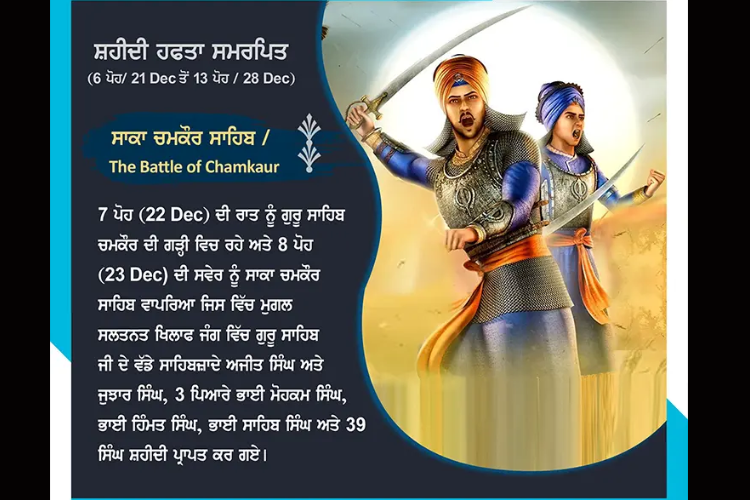Shaheedi Diwas Vadde Sahibzade 2022 is to be observed on December 23rd, Saturday accordingly 8 Poh 555 Nanakshahi. It was the day when the battle of Chamkaur was fought on 22nd December 1704 between Mughal Coalition forces under the command of Wazir Khan against 40 Companions of 10th Guru Gobind Singh Ji.
| Event Name | CE Date | Nanakshahi Date Date |
|---|---|---|
| Martyrdom Day of Sahibzada Ajit Singh Jujhar Singh ( Shaheedi Diwas Vadde Sahibzade ) |
23rd December 2023, Saturday | 8 Poh 555 |
Sahibzada Baba Ajit Singh And Baba Jujhar Singh
Background: The Hill Chiefs were keenly watching the growing influence of Guru Gobind Singh. They had their fears and suspicions. They wanted to contain the Guru or end his life to curb the Sikh movement. Pahadi Kings gathered their combined forces to challenge the Guru at Bhangani-Paonta Sahib in 1688. The Guru, supported by his followers and friends like Pir Budhoo Shah, met the challenge gallantly and defeated the Rajas. Thereafter, the Guru went to Anandpur Sahib and at the place called Nadaon in 1691, he again gave a crushing defeat to the Rajas.
In 1699 the Guru baptized a large number of his followers at Kesgarh (Anandpur) to resist in an organized manner the oppression of conversion by the state. Receiving the reports of Guru’s activities, coupled with the complaints of the Hill Chiefs, who had been seeking help from Emperor Aurangzeb issued orders for a military operation against the Guru. Large-scale fighting started in 1701 and continued for three years i.e., up to 1704 at Anandpur Sahib. The military generals namely Wazir Khan and Zabardast Khan sent several messages on oath of Quran (Holy book of Muslims), and cow, by the Hill Chiefs, to the Guru to vacate Anandpur on the promise of safe passage. The guru did not rely on such oaths. But he was requested by his followers to do so because of the prolonged siege leading to frustration. The enemy was curiously watching every movement of the Guru.

On the intervention of the Royal Emissary of Aurangzeb, the Khalsa contingent vacated the precincts of Anandpur Sahib. The treacherous enemy fell upon them. Fierce fighting took place at every step to the detriment of both sides. Extremely outnumbered the Khalsa gave way and dispersed in all directions. Some men remained with the Guru and crossed the river Sirsa whence they preceded in the direction of Chamkaur. Two elder Sahibzada were with the Guru whereas the two younger ones along with Mata Gujri escaped to some other direction.
Fighting was going on at every step when the Guru after vacating the Anandpur fort took shelter in a mud-house (Haveli) at Chamkaur. Pursuing forces laid a siege around the Haveli in which the Guru with a handful of men planned a strategy to hold the enemy advance by keeping them engaged in fighting till nightfall. History does not record a battle similar to one fought at Chamkaur, where courage, bravery, and fortitude in each batch of five Sikhs displaying unparallel chivalry challenged the might of several lakhs (metaphorically, the actual number is unknown till today) of enemy soldiers and stunned them with their fighting spirit. It was probably here that Guru Gobind Singh claimed, “One Sikh will fight against a hundred and quarter thousand tyrants.
Baba Ajit Singh
The eldest son of Guru Gobind Singh, Baba Ajit Singh was born at Anandpur on 7th January 1687 AD. He was given proper training in the use of war weapons, especially archery and swordsmanship. He took part in all the battles fought by the Guru & showed his proficiency in the use of arms. On the battlefield wherever he was posted he stood like a rock and pushed the advancing enemies back. In a horrible situation at Chamkaur, Baba Ajit Singh requested his father to allow him to go out of the Haveli with five Sikhs to stall the enemy. The Guru, with an affectionate pat, granted his request. When Ajit Singh thundered in the field, he remained out of reach of the enemy for hours.
He excelled in the use of war weapons such as archery and swordsmanship. Whosoever thought of going near him faced sure death. He was a terror for the enemy on the battlefield. As long as the arrows lasted in his quiver, he held the enemy soldiers at a distance. But with his weapons, his sword plunged into a hand-to-hand fight. Hundreds of enemy soldiers encircled him from all sides narrowing the distance with every movement. He fell fighting to the last with the glow of a martyr on his face.
Baba Jujhar Singh
The second son of Guru Gobind Singh was born in 1689 at Anandpur. He was 16 years old when he participated in the battle of Garhi Chamkaur. He had seen how his elder brother fought and fell. Baba Jujhar Singh Ji requested his father to allow him to go out of the Garhi and fight against the forces of injustice and evil. The Guru equipped him with a sword and shield and gave him an encouraging pat. He went out with five Sikhs. While fighting bravely, he felt thirsty and came back to the Guru for water. The Guru forgetting the relationship turned his back on him and said that a soldier returns from the battlefield victorious on vanquished. The son got the hint and rode back to the field roaring like a hungry lion. While fighting he advanced into the thick of the enemy rows until he was overpowered and slain.
Let’s remember the Vadde Sahibzade on their Shaheedi Diwas, we should not mourn their death but celebrate their martyrdom. It’s our tradition, as Sikhi flourished on the blood of our martyrs.




